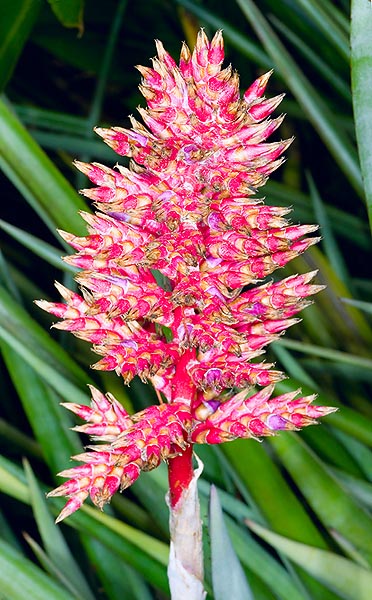Family : Bromeliaceae

Text © Pietro Puccio

English translation by Mario Beltramini

The inflorescence is a 26-30 cm long, compound raceme © Mazza
is native to the humid forests of Argentina, Bolivia, Brazil and Paraguay.
The name of the genus comes from the Greek “aichme” = spearhead, with reference to the thorny apices of the sepals and of the floral bracts; the name of the species is the combination of the Greek words “distichos” = two lines, distich and “ánthos” = flower, with reference at the disposition of the flowers into the inflorescence. The variety was honoured to the French collector Frederic Schlumberger (1823-1893).
Common names: “caraguatà” (Spanish).
Evergreen herbaceous plant, monocarpic (bearing fruit only one time during its existence), acaulescent, epiphyte or saxicolous, it has a funnel-shaped rosette of several green-grey leaves, due to the presence of small grey scales, placed in such a way to form a central cavity usually full of water.
The leaves are linear, rigid, about 1-1,5 m long and 3-8 cm broad in the central part, thin towards the extremity which is provided with a robust thorn; the edges have also approached brown thorns, long 2-3 mm. The inflorescence, at the centre of the rosette, is formed by a floral scape covered by a white tomentum and provided with elliptic superimposed bracts, longer than the internodes, of green or pink colour, usually unarmed.
The scape ends with a 26-30 cm long, fusiform, inflorescence, formed by a compound raceme, that is formed by several racemes departing from the central axis. The bracts under the single racemes, usually shorter than the same, are oval and with a thorn at the apex, of pink colour and covered by a white tomentum; of the same colour are those of the single flowers, long 5-7 mm and placed on two opposite lines (distichous).
The flowers have 5-12 mm long sepals, of the same colour as the bracts, with a thorn at the apex, and about 2 cm long, blue, purple or white, petals. The fruits are cylindrical berries covered by a white tomentum. It reproduces, besides by seed, by vegetative way through the new plants which come out at the base and which can be detached when they have at least the size of one third of the mother plant. Robust plant, cultivable in open air in the tropical and humid subtropical climates as epiphyte on the trees, but also as terrestrial, to form edges and flower-beds, on very aerated, porous, draining and rich of organic substance substrata, in a usually shaded position.
Its cultivation can be tried also in the warm temperate climates, in sheltered location, as it can stand, for short time, temperatures as low as -3°C. It can be cultivated in pot for decorating spacious indoors, seen the dimensions and the presence of the thorns at the edges and at the tip of the leaf, verandas and winter-gardens, in very luminous position, but not at the direct sun, and on a draining, very porous and aerated substratum, which may be formed by peat and sand or other inert materials (agriperlite, vermiculite, etc.), with temperatures which must be kept over the 14-16°C, best 20-24°C. Watering must be regular in summer, but leaving the surface stratum of the mould to dry up before watering again, and reduced in winter, and the ambient humidity, in presence of dry air and high temperatures, can be increased with nebulisations utilizing water at room temperature and not calcareous, in order to avoid anti-aestethic dots on the leaves. In summer, some water can be left in the central cavity formed by the rosette of leaves, renewing it frequently to avoid the formation of mosquito larvae nest, whilst in winter it is better to leave it dry for avoiding possible rottenness.
Synonyms: Chevaliera grandiceps Griseb. (1879); Aechmea grandiceps (Griseb.) Mez (1892); Aechmea polystachia var. longifolia A.Cast. (1925); Aechmea rubra Silveira (1931); Aechmea involucrifera Mez (1934); Platyaechmea distichantha var. schlumbergeri (E.Morren ex Mez) L.B.Sm. & W.J.Kress (1990).
→ For general notions about BROMELIACEAE please click here.
